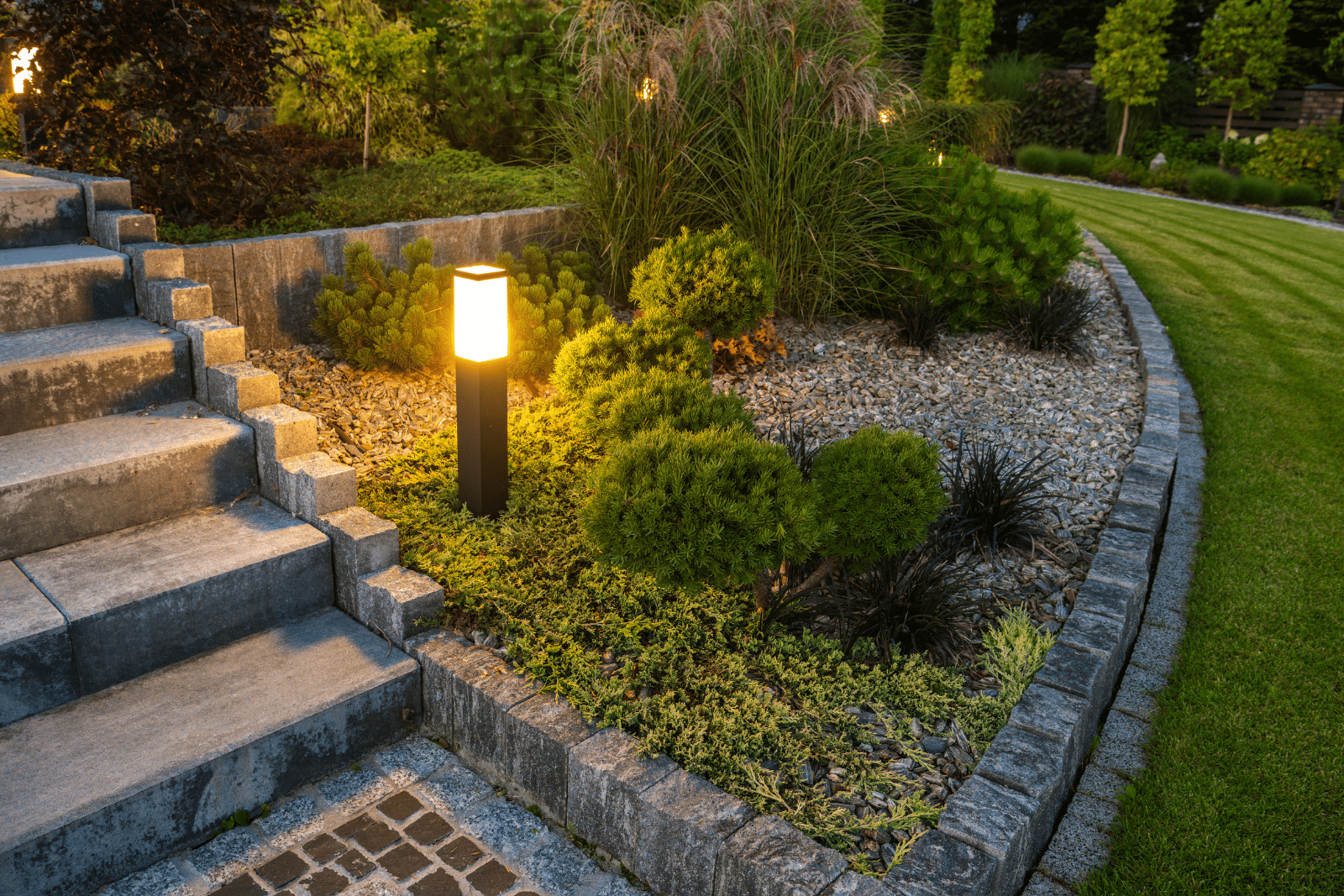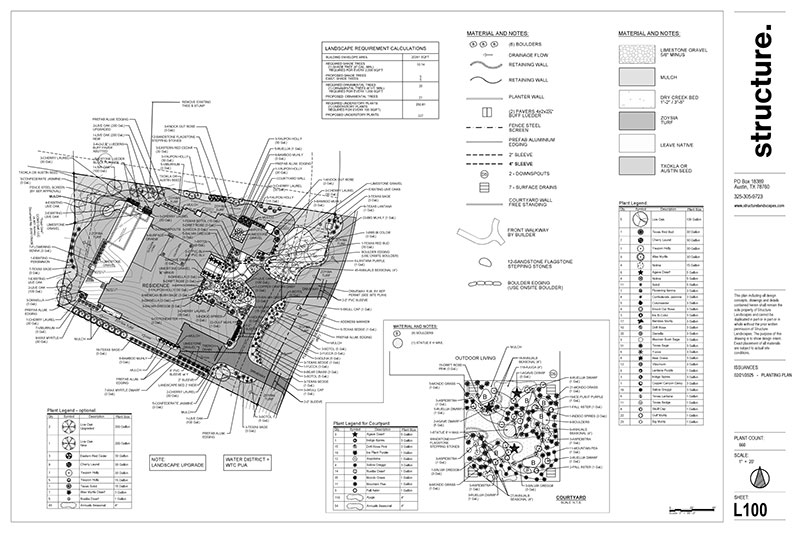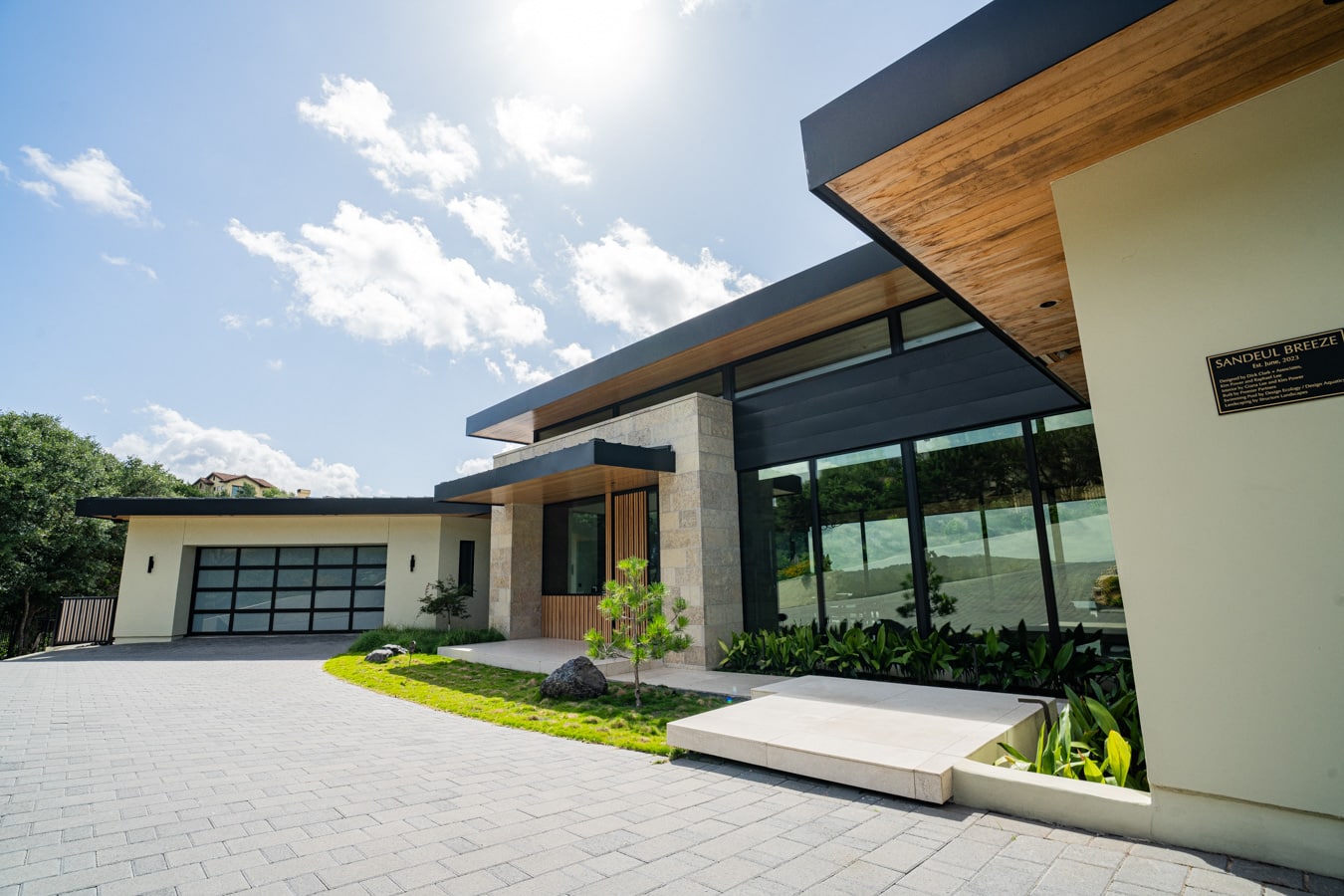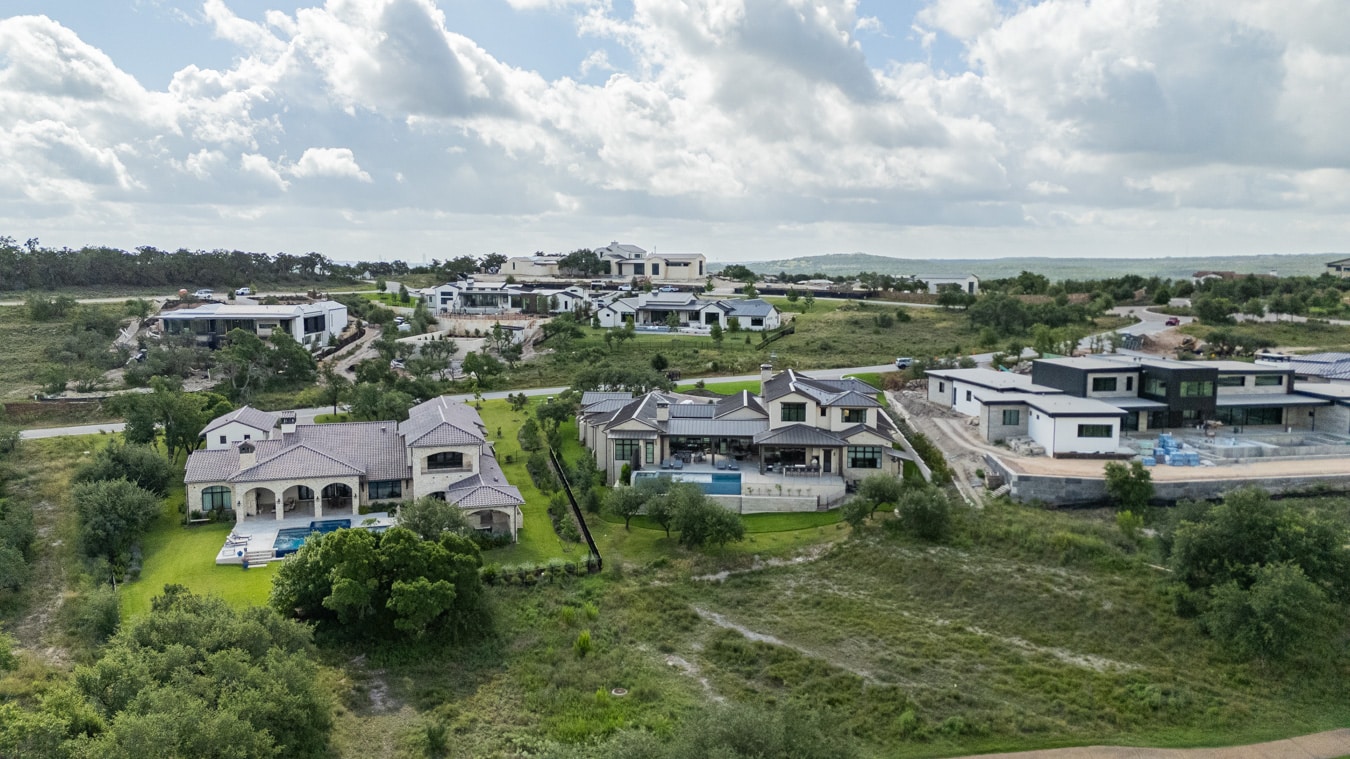Transforming your outdoor space with landscape lighting enhances both aesthetics and functionality. Proper landscape lighting can highlight garden features, improve safety, and extend the enjoyment of your outdoor areas after dark. When thoughtfully designed, it adds a warm ambiance and creates inviting spaces for gatherings or quiet evenings.
Consider how outdoor lighting can elevate your home’s curb appeal. With a variety of styles and techniques available, our landscape architects at Structure Landscapes will work with you to create the perfect ambiance, ensuring your outdoor area becomes a captivating retreat after sunset.
Understanding Landscape Lighting
Landscape lighting serves the purpose of illuminating outdoor areas to improve visibility and aesthetic appeal. It can highlight pathways, gardens, and architectural features while enhancing curb appeal.
When designing your lighting plan, consider factors such as the layout of your outdoor space and the desired atmosphere. Effective landscape lighting combines various techniques, including uplighting and downlighting, which can create different lighting effects.
Proper lighting may also deter crime by increasing visibility, making your home feel safer. Always consider energy efficiency; options like LED fixtures consume less power and have a longer lifespan than traditional incandescent bulbs.
Types of Landscape Lighting Fixtures
The landscape lighting market offers a variety of fixtures to meet different needs. Here are some common types:
Path Lights: Ideal for illuminating walkways and driveways, they ensure safe navigation.
Spot Lights: These fixtures focus on specific areas, such as trees or architectural elements, drawing attention to their beauty.
Flood Lights: Used for broader illumination, flood lights can enhance security and visibility in larger outdoor areas.
Step Lights: Placed on steps or low walls, they provide safety by reducing the risk of tripping.
Well Lights: Installed in the ground, these fixtures illuminate plants or structures from below, creating a dramatic effect.
Bollard Lights: These fixtures are ideal for pathways, providing both lighting and design elements to the landscape.
Garden Lights: Specifically designed for illuminating garden beds, they help showcase plant life and flowers.
Choosing the Right Lighting for Your Space
Selecting suitable lighting for your outdoor space involves evaluating your specific requirements. Consider the size of the area, the focal points you wish to highlight, and the mood you want to create.
Determine whether you prefer solar options, which are energy-efficient and easy to install, or wired fixtures that provide more consistent illumination.
Voltage is another factor to take into account. Low-voltage systems are safer and simpler for residential settings, while line-voltage systems offer greater brightness.
Design also plays a crucial role. Plan your layout to avoid overcrowding and ensure a harmonious blend with existing elements in your landscape. A well-thought-out lighting plan can enhance the utility and beauty of your outdoor environment.
Choosing the Right Lighting for Your Space
Creating a thoughtful landscape lighting design enhances the aesthetic appeal and functionality of your outdoor spaces. Focus on key elements such as light placement, techniques, and color temperatures to achieve your desired mood and effect.
Creating an Effective Lighting Plan
Begin by assessing your landscape and identifying areas that require illumination. Highlight features like walkways, patios, and gardens using an effective plan. Consider the function of each space.
For example, use path lights along walkways for safety while emphasizing greenery with spot lights. For larger areas, flood lights provide broad coverage. Ensure all fixtures are weather-resistant to withstand outdoor elements.
Create a balanced lighting scheme by combining different types of fixtures. Place lights at varying heights for depth and dimension.
Lighting Techniques and Effects
Implement various lighting techniques to enhance the visual appeal of your landscape. Uplighting casts light up from the ground, showcasing trees and statues dramatically. Shadowing creates interesting patterns and depth by placing lights strategically.
Consider the beam spread of your fixtures. A narrow beam can spotlight specific features, while a wide beam floods a larger area with light. Mix techniques to create layers of light and shadow that add character to your outdoor spaces.
Use dimmers and timers to adjust the intensity and timing of your lights, adapting to different occasions and moods.
Color Temperature and Mood
The color temperature of your lighting significantly influences the ambiance of your landscape. Measured in Kelvins, options range from warm (2700K-3000K) to cool (4000K+).
Warm lights create a cozy and inviting atmosphere, ideal for residential backyards and patios. Cooler lights can lend a modern, energetic feel to outdoor spaces.
Choose lighting fixtures that complement the overall design. Mix color temperatures for visual interest and to direct attention to specific areas or features. The right temperature establishes a mood that enhances your outdoor gatherings or quiet evenings.
Technical Aspects of Landscape Lighting
Understanding the technical components of landscape lighting is essential for effective installation and operation. Key factors to consider include power sources, voltage levels, and bulb types.
Power Sources and Transformers
In landscape lighting, power sources can vary between solar, low-voltage, and hardwired systems. Transformers are crucial for converting standard line voltage (120V) to a low voltage (typically 12V) suitable for outdoor fixtures.
Low-voltage systems enhance safety and efficiency. Using a transformer, you can connect multiple fixtures without losing brightness. When selecting a transformer, consider the total wattage of your fixtures to avoid overloading the system.
Landscape Lighting Voltage
Voltage plays a significant role in the performance and safety of landscape lighting. Most residential outdoor lighting operates at low voltage (12V), which reduces the risk of electrical shock.
Low-voltage systems are easier to install and maintain than high-voltage alternatives. They typically require less wiring and can use flexible cables, making them adaptable to various layouts.
Ensure your fixtures are rated for the specific voltage to guarantee optimal functionality. Poor voltage compatibility can lead to dim lights or increased energy use.
LEDs vs Incandescent Bulbs
When choosing bulbs, you have two primary options: LEDs and incandescent bulbs.
LEDs are energy-efficient, consuming up to 75% less power and lasting significantly longer than incandescent options. Their low heat output reduces fire hazards and allows for safe placement near foliage.
In contrast, incandescent bulbs are less efficient and have a shorter lifespan. While generally cheaper upfront, they incur higher electricity costs and require more frequent replacements.
When making your choice, consider the total cost of ownership, including initial investment and energy savings. LED lights can provide long-term savings and lower maintenance.
Installation and Setup
Proper installation of landscape lighting enhances both functionality and aesthetics. You will need to consider wiring, safety measures, and control options as they are key to an effective setup.
Step-by-Step Installation Guide
- Plan Your Layout: Map out where you want the lights to illuminate important features like pathways, trees, or architectural elements.
- Select the Right Fixtures: Choose durable fixtures suitable for outdoor use. LED packages are recommended for energy efficiency.
- Gather Materials: Ensure you have all necessary tools and materials, including stakes, connectors, and wiring.
- Install Fixtures: Position the lights at your predetermined spots. Secure them firmly, using stakes or mounting brackets as needed.
- Wiring Installation: If using hardwired systems, bury cables at least 6–12 inches deep to avoid damage. Connect fixtures as instructed.
- Test Your Setup: Before finalizing, turn on the system to check the lighting angles and intensity.
Timer and Control Options
Timers provide convenience and control over your landscape lighting. You can choose from digital or mechanical timers, which can be set for specific on/off times.
Photocell controls allow lights to turn on automatically at dusk and off at dawn, saving energy and ensuring lights function only when needed.
Exploring smart home integrations can enhance user experience. Systems often allow manual control via smartphone apps that enable you to adjust settings remotely.
Motion sensors add an extra layer of security and functionality, activating lights when movement is detected within a set range. This can be particularly beneficial for enhancing safety around pathways or entrances.
Decorative Elements and Supplementary Lighting
Adding decorative elements can significantly improve the visual appeal of your landscape. Options like string lights create a whimsical atmosphere, perfect for outdoor gatherings.
Consider incorporating hardscape lighting to highlight features like pathways or retaining walls. Water features illuminated with specialized lights can enhance the serene ambiance of your garden. Tree lights can accentuate the natural beauty of your plants, providing an enchanting view at night.
Weather Resistance and Durability
Choosing materials designed for durability ensures your lighting withstands environmental challenges. Weather-resistant and waterproof fixtures are essential for longevity, preventing damage from rain or snow.
Materials like stainless steel and brass are ideal due to their corrosion resistance. Always check the lumens output for adequate brightness, ensuring that your chosen fixtures perform well in various weather conditions. Investing in quality accessories will maintain the effectiveness and longevity of your landscape lighting system.
Evaluating Quality and Pricing
Compare pricing among different brands, as costs can vary significantly. For example, basic LED packages typically range from $50 to $200. Higher-end options like Hampton Bay and Kichler often price their kits from $200 to $600, reflecting quality and durability.
Consider warranties too. Products with extended warranties often indicate better quality. Look for at least a two-year warranty, which can offer additional peace of mind regarding your investment.
Brand Comparisons and Recommendations
Choosing a reputable brand is crucial. Brands such as Hampton Bay and Kichler are known for quality and reliability. Kichler offers a wide selection and frequently receives high ratings for its designs and durability.
If you’re on a budget, P.M. Lighting provides economical options without sacrificing quality. Research customer reviews to gauge satisfaction. Look for products backed by positive feedback and proven performance over time.
Brands often have starter kits for beginners, which can save you money while allowing you to test their products.
Where to Buy Landscape Lighting
You have a variety of purchasing options. Popular home improvement stores often stock landscape lighting kits, ensuring you can find products in-store. Online retailers also provide customer reviews that can help guide your choice.
Exploring online marketplaces can provide discounts or package deals. Make comparisons to secure the best pricing and ensure your selected product meets the quality standards needed for your landscape lighting project.
Frequently Asked Questions
Choosing landscape lighting involves considerations of style, design, and energy efficiency. Below are common questions that can help you navigate your options.
How to choose the best low voltage landscape lighting for my home?
When selecting low voltage landscape lighting, consider the size of your outdoor space and desired illumination levels. Look for fixtures that match the design aesthetic of your home and ensure they are rated for outdoor use. Test different bulb types to find the right brightness and color temperature.
What design principles should I consider for effective landscape lighting?
Use layering techniques by combining ambient, task, and accent lighting. Highlight key features such as trees, pathways, and architectural elements. Maintain balance in light distribution to avoid overly bright or dark areas, which can disrupt the overall appearance of your landscape.
What are the benefits of solar versus wired landscape lighting?
Solar lighting offers easy installation and is cost-effective since it relies on sunlight. However, it may provide lower brightness and shorter runtime. Wired systems are more reliable for consistent performance, allowing for brighter lights and longer durations but involve a more complex installation process.
What should I know before attempting a DIY landscape lighting installation?
Before starting a DIY project, familiarize yourself with local regulations regarding electrical work. Plan your layout carefully, ensuring proper spacing and alignment of fixtures. Select high-quality materials to avoid issues like water damage or reduced performance over time.
Why might landscape lighting vary in cost, and what factors influence it?
Cost variations stem from the type of fixtures, materials, and installation methods. High-end fixtures with advanced features will cost more. Additionally, labor costs can fluctuate based on the complexity of the installation and the local market.
What is the most energy-efficient landscape lighting available today?
LED landscape lights are the most energy-efficient option, using significantly less energy than traditional incandescent bulbs. Look for fixtures with ENERGY STAR certifications for maximum efficiency. These options not only save money on energy bills but also have a longer lifespan.
Contact us today at (512) 461-0290 to schedule a consultation and learn more about how our landscape lighting and landscape design services can transform your outdoor spaces.





